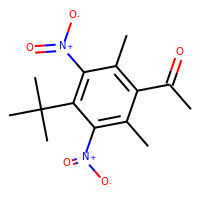
Musk ketone
| Chemical identification | |
|---|---|
| Pubchem identifier | 6669 |
| CAS identifier | 81-14-1 |
| DSSTOX identifier | DTXSID6025690 |
| IUPAC name | Musk ketone |
| SMILES | CC1=C(C(=C(C(=C1[N+](=O)[O-])C(C)(C)C)[N+](=O)[O-])C)C(=O)C |
| InChI | InChI=1S/C14H18N2O5/c1-7-10(9(3)17)8(2)13(16(20)21)11(14(4,5)6)12(7)15(18)19/h1-6H3 |
| InChIKey | WXCMHFPAUCOJIG-UHFFFAOYSA-N |
| Synonyms | Acetophenone, 4'-tert-butyl-2',6'-dimethyl-3',5'-dinitro-; 4-tert-Butyl-3,5-dinitro-2,6-dimethylacetophenone; 4'-tert-Butyl-2',6'-dimethyl-3',5'-dinitroacetophenone; Ethanone, 1-(4-(1,1-dimethylethyl)-2,6-dimethyl-3,5-dinitrophenyl)-; 3,5-Dinitro-2,6-dimethyl-4-tert-butylacetophenone; 2-Acetyl-5-tert-butyl-4,6-dinitroxylene; 2,6-Dinitro-3,5-dimethyl-4-acetyl-tert-butylbenzene; 1-(4-(1,1-Dimethylethyl)-2,6-dimethyl-3,5-dinitrophenyl)ethanone; Musk ketone |
| Odor profile | |
|---|---|
| Odor classes | Aromatic, Citrus, Dairy, Edible oil, Fermented, Floral, Grain, Herbs, Maillard, Mineral, Pome, Processed meat, Stone spices, Sweet spices, Vegetable |
| Reference | [1] |
| Presence in Children's products | |
|---|---|
| Broad category | Hair care |
| Subcategory | Baby Shampoo And Shower Gel |
| Chemical classification based on ClassyFire | |
|---|---|
| Chemical kingdom | Organic compounds |
| Chemical super-class | Organic oxygen compounds |
| Chemical class | Organooxygen compounds |
| Chemical subclass | Carbonyl compounds |
| Synthetic product source | |
|---|---|
| Product source | Fragrance in cosmetics |
| Reference | [1] |